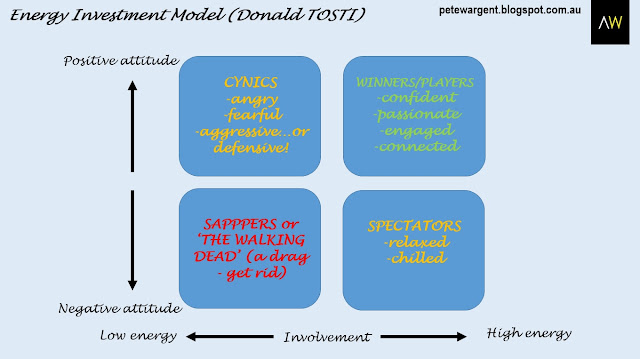A fair few years have been swept under the bridge now since I studied Business Management, but with quite a bit of real world experience under my belt I thought it might be an opportune time to look at how you might go about building a great team. 
The process all starts with attempting to pick out the right people in the first place, which is probably 80 per cent of the battle in my experience, the rest being largely fine-tuning.
A chap with many letters after his name, Mr. Donald Tosti, designed the following 'Energy Investment Model' framework to profile the four different types of members of a team.
In an ideal world, what you want are life's players or winners, with a high level of energy and a relentlessly positive attitude.
Of course, everyone wants to hire these people, so it's not always that easy!

At the other end of the scale there are the 'walking dead', those sad folks with a low level of energy and a negative attitude to boot, what the SAS might refer to as 'energy sappers'.
These people are often life's victims: every challenge or problem is someone else's fault.
The model is meant to be flexible rather than fixed, and many of us have had bad days or have worked in the wrong jobs where we spent some time in this quadrant!
The Royal Marines would instantly dismiss candidates they expect to reside in this category, and if you want to build a great team, then you must do the same.
Take a look through your social media feeds.
Do you know any people who fit this category?
Me too.
In reality, many team members are often likely to be positioned somewhere in the top right quadrant (cynics, that love a good whine!) or bottom right quadrant (spectators), and these people may require coaching into the top right quadrant over time.
In my experience, there is far more hope for winning a cynic over than a spectator or drifter with no energy and an ability to continually resist change or taking action.
Spectators might speak positively of the group on occasion, but they rarely contribute anything meaningful.
Probably most people I know and associate fit into the cynic category, at least on my Twitter feed.
They are typically very competent, but are often in some way frustrated.
"FIFO" (fit in or...do one)
If you're serious abut building a great team, then you need to set about coaching the hopefuls towards the top right quadrant, and if they don't conform, then it's time to implement FIFO.
In this context, I don't mean 'first in first out', I mean, 'fit in or...erm, you know, Foxtrot Oscar'.
This may sound harsh, but this blog post is about how to build a great team, not an average team. 
The dynamics of how a team then develops its respective roles and characteristics is known in MBA-speak as "forming, storming, norming, and performing"
This is Tuckman's Stages of Group Development model, and Tuckman later added "adjourning" as a fifth stage - during these stages you can fine-tune how the team operates.
But, for me, I reckon 80 per cent of the battle is getting the right people on board in the first place.
Try to find the positive players who will consistently support the improvement of your team with their actions and their deeds.














